Dividing Daylilies
By: Brooke Garcia
My backyard is currently a construction zone, and I have spent the last month dividing iris and daylily plants in efforts to save them from being ran over by the Bobcat (and no I’m not talking about the animal). 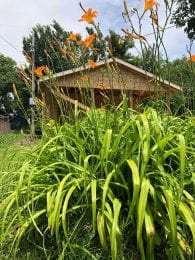 With our future garage being built, we have had to move hundreds of iris and daylily plants into a new garden bed. Being a horticulturist by trade, I couldn’t see these plants go to waste.
With our future garage being built, we have had to move hundreds of iris and daylily plants into a new garden bed. Being a horticulturist by trade, I couldn’t see these plants go to waste.
I know it isn’t the ideal time to be moving these plants around, as several of them have recently bloomed. Generally, I’d suggest to wait to divide these plants until they have completed their bloom cycle (late summer/early fall). You can also divide them in the early spring prior to blooming, but this could impact their blooms later in the season. The steps to this process are relatively simple, but you should expect your hands to get a little dirty. It can also be a little time-consuming.
Step 1: Dig up a clump of daylilies with a shovel or hand trowel. I have found the process moves more quickly when you grab a shovel and do larger sections. In our case, we had hundreds to move…. so the bigger the clumps, the better!

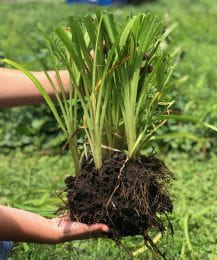
Step 2: Trim the daylily leaves and flowers to a height of 8-12 inches. Pictured above on the right, you will notice the final clump cut back to approximately 12 inches.
Step 3: Separate the clump of daylilies into smaller clumps. My preference is to keep the clumps in groups of 2-3 plantings to keep the transplant looking full. Looking at the pictures below, the bottom left shows a single plant divided from the clump of daylilies. Pictured on the bottom right, I kept two plants clumped together for one single planting.

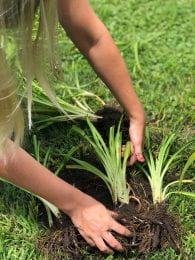
Step 4: Loosen the soil away from the roots of the recently divided plants. Next, trim the roots of your plants to stimulate new root growth. Only trim a small amount of the roots, as this will be enough to stimulate new healthy growth. (See pictures below)
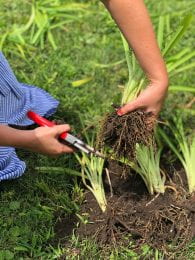
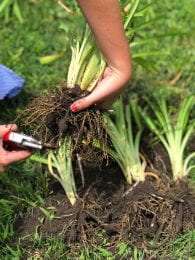
Step 5: You’re ready to plant your newly divided daylilies! Be sure that you choose a sunny location in your garden with well-drained soil. Generally, I dig a hole 2-3x the size of the root ball of my plant. Once you place your newly divided plant into its newly dug home, add additional compost or garden soil into the hole. Gently pack the soil around the new planting. Be mindful to keep the crown of the plant above the soil line.
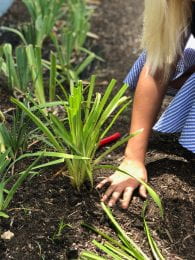
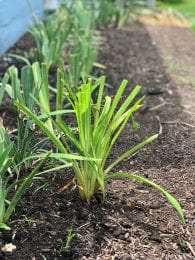
Step 6: Don’t forget to water your freshly divided daylily plants. If you plan to transplant more, space the plantings 12-18 inches apart to give them room to grow. Daylilies can begin to get crowded after 4-5 years.
Daylily Leaf Streak
By: Judy O’Mara
Daylilies are a great fit for Kansas. There are many varieties that grow well here. I particularly like browsing the photo gallery at the Flint Hills Daylily Society chapter (https://www.flinthillsdaylily.org/gallery) for my favorite ones. They are mostly problem free but I did recently see some daylily streak (Aureobasidium microstictum) on a recent walk. It isn’t that common in Kansas, but wet conditions this spring likely the triggered the disease.
Daylily leaf streak starts as long yellow streaks that turn a reddish brown. Heavily infected leaves scorch back and die early.
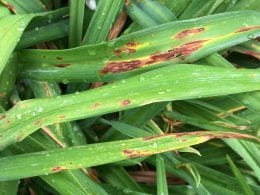
The disease is favored by moderate temperatures and wet conditions. Daylily streak can spread by splashing water droplets. Although you can’t manage the rain, you can time irrigation so that your plants are watered in the morning. This allows leaves to dry out quickly and reduce conditions that favor disease development. A mature daylily planting can be crowded leading to poor air circulation and prolonged periods of leaf wetness. Good plant spacing will improve air flow and help to dry out plants quickly. The disease can also be moved on tools, so avoid working around wet plants
Inspect plants when purchasing them and always start with healthy, disease-free plants (ie no spots on the leaves). If just one plant in the landscape is showing symptoms, you might be able to stay ahead of the disease by picking off and dispose infected leaves. Daylily leaf streak will overwinter in the leaf litter, so cleaning up the flower bed will help to reduce the amount of disease that is carried over to the next growing season. If daylily leaf streak shows up annually, it might be worth isolating the problem daylily from the rest of the planting.
The best strategy for managing day lily leaf streak…is through the use of resistant cultivars. Disease susceptibility varies and lists of resistant varieties are not easily available. A few varieties reported by Clemson University are: Betty Bennet, Edna Spalding, Ella Pettigrew, Globe Trotter, Nancy Hicks, Pink Superior, Ron Rousseau, Sudie, Tropical Tones, Upper Room, and Winsome Lady. (https://hgic.clemson.edu/factsheet/daylily-diseases-insect-pests/)
